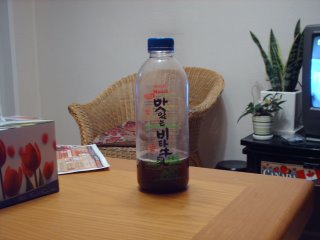Aesthetic Pursuits
The latter part of that last sentence touches upon an issue that I have wanted to address here on my blog but have been hesitant to thus far. To write about these issues as a white person, and a white American male at that, is extremely difficult because my experience of race has been one of privilege in the extreme, and so my observations are, naturally, affected by my experiences and I risk the possibility of sounding racist (and sexist for that matter). However, I feel that I must say something about this because it has made me feel uncomfortable on more than one occasion. I've written before about how often I am called "handsome"* here by people I may not even know, even though back in the States I don't think anyone (besides my mother) would rate me amongst the most handsome of people. And I feel that much of this phenomenon has to do with the fact that I'm white. The perception of race in Korea, however one may define it, seems to me to be different from the way we look at it back in the States (which isn't in and of itself surprising since racial perceptions, stereotypes, and hierarchies tend to differ from social group to social group). The desire to enlarge the size of one's eyes, for example, certainly stems, in part, from a desire to look more white. I say "white" because, given my students reactions to pictures of Tiger Woods in one of our textbooks (e.g. "His skin is dirty teacher!," "He is ugly!," "I think he is maybe dangerous," etc.), I doubt that Korean women and men are augmenting the size of their eyes so they can look more like Denzel or Beyonce, let alone Gael Garcia Bernal or Salma Hayek. America, with all of its shortcomings, does indeed have a more diverse complexion than Korea. And even though racially hierarchized standards of beauty certainly exist in America, I believe that there is more diversity among what (and who) is considered "beautiful" there than there is here. I remember an incident early on in my teaching career here when one of my Korean colleagues asked me if all Americans have the retractable eyelid like Jessica and I have, to which we replied, "Well, pretty much everyone except the Asian-Americans," invoking one of our own cognized racial categories in the process. Reflecting on that episode, I wonder if my colleague equated "American" with "white" in her mind, even though white Americans aren't the only ones with retractable eyelids. Which leads me to wonder whether the apparent Korean desire to learn "American" English means that they expect their children's teachers to be white (because in their opinion non-white teachers must not speak the "proper" English) and whether that has something to do with why it is more difficult, from what I hear, for non-white foreigners to land a position as an EFL instructor in Korea. It's as if their children's English education isn't authentic unless it's administered by "whitey."
In summation, I don't mean to suggest that Korean women, or men, want to look more "white" and that's why plastic surgery has become so popular among young Koreans recently. However, I do believe that racially charged perceptions of the world exist in Korea (as they do most anywhere) and that my current profession has a seriously problematic relationship with these perceptions. Obviously, this needs to be investigated further, but I am curious if any of you reading this have any comments to add to this discussion.
Here are a couple of other links to mainstream articles about Korea and plastic surgery.
*Although, many of my students also ridicule me relentlessly for my big nose and hairy arms, face, and chest and call me "ugly" in a daily basis.



